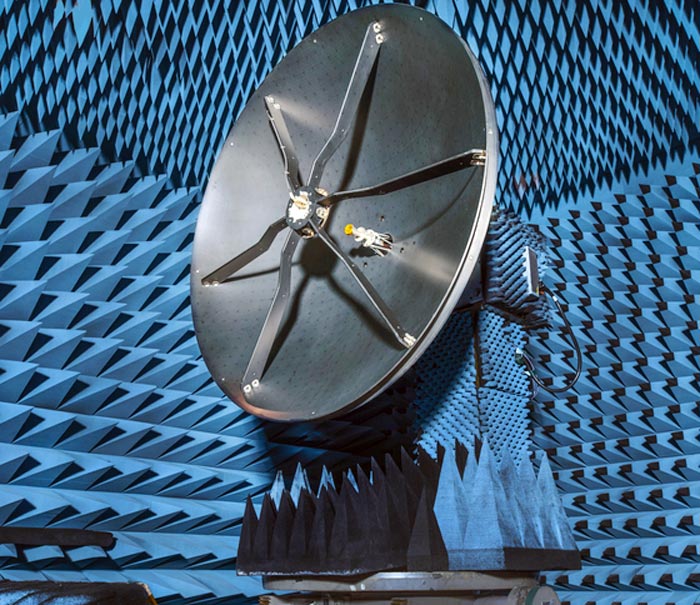
High-Gain Antenna for NASA’s Roman Mission Clears Environmental Tests

Engineers at NASA's Goddard Space Flight Center in Greenbelt, Maryland, have finished testing the high-gain antenna for the Nancy Grace Roman Space Telescope.
Credit: NASA/Chris Gunn
Engineers at NASA’s Goddard Space Flight Center in Greenbelt, Maryland, have finished testing the high-gain antenna for the Nancy Grace Roman Space Telescope. When it launches by May 2027, this NASA observatory will help unravel the secrets of dark energy and dark matter, search for and image exoplanets, and explore many topics in infrared astrophysics. Pictured above in a test chamber, the antenna will provide the primary communication link between the Roman spacecraft and the ground. It will downlink the highest data volume of any NASA astrophysics mission so far.
The antenna reflector is made of a carbon composite material that weighs very little but will still withstand the spacecraft’s wide temperature fluctuations. The dish spans 5.6 feet (1.7 meters) in diameter, standing about as tall as a refrigerator, yet only weighs 24 pounds (10.9 kilograms).
Its large size will help Roman send radio signals across a million miles of intervening space to Earth. At one frequency, the dual-band antenna will receive commands and send back information about the spacecraft’s health and location. It will use another frequency to transmit a deluge of data at up to 500 megabits per second to ground stations in New Mexico, Australia, and Japan. These locations are spread out so the Roman team will consistently be able to communicate with the spacecraft.
Producing this antenna was a coordinated effort between the government and the commercial sector. NASA was responsible for the radio frequency design and fabrication of the feed assemblies. A commercial partner, Applied Aerospace Structures Corporation (AASC) in Stockton, California, was contracted for the final flight mechanical design and fabrication of the composite reflector and strut assembly.
The completed antenna was delivered to NASA in December. Engineers at AASC and Goddard have extensively tested it to confirm it will operate as expected in the extreme environment of space, where it will experience a temperature range of minus 26 to 284 degrees Fahrenheit (minus 32 to 140 degrees Celsius). The team also put the antenna through vibrational testing to make sure it will withstand the spacecraft’s launch.
Engineers measured the antenna’s performance in a radio-frequency anechoic test chamber, shown in the photo above. Every surface in the test chamber is covered in pyramidal foam pieces that minimize interfering reflections during testing. Next, the team will attach the antenna to the articulating boom assembly, and then electrically integrate it with Roman’s Radio Frequency Communications System.
For more information about the Roman Space Telescope visit: https://roman.gsfc.nasa.gov/ or www.nasa.gov/roman. To virtually tour an interactive version of the telescope, visit: https://roman.gsfc.nasa.gov/interactive/.
Media Contacts
Ashley Balzer
NASA/Goddard Space Flight Center
ashley.m.balzer@nasa.gov
Cell: 3013103306
Claire Andreoli
NASA/Goddard Space Flight Center
claire.andreoli@nasa.gov
Office: 301-286-1940












